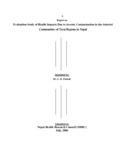Please use this identifier to cite or link to this item:
https://hdl.handle.net/20.500.14356/346Full metadata record
| DC Field | Value | Language |
|---|---|---|
| dc.contributor.author | Nepal Health Research Council (NHRC) | |
| dc.contributor.author | Pathak, L. R., Dr. | |
| dc.date.accessioned | 2013-01-02T21:51:45Z | |
| dc.date.accessioned | 2022-11-08T10:14:26Z | - |
| dc.date.available | 2013-01-02T21:51:45Z | |
| dc.date.available | 2022-11-08T10:14:26Z | - |
| dc.date.issued | 2006 | |
| dc.identifier.uri | http://103.69.126.140:8080/handle/20.500.14356/346 | - |
| dc.description.abstract | EXECUTIVE SUMMARY Arsenic contamination in drinking water has been one of the biggest epidemics of the global concern including Bangladesh, India and Nepal. The long term continued exposure to arsenic leads to Arsenicosis, which has no definite medical cure. Thus, assessment of the socio-economic dimensions of the arsenic hazard becomes a first step toward preventive measure. The general objective of the study is to evaluate the health impacts of arsenic contamination on human health through drinking water in Ramgram and Lahan Municipality and Swathi, Hakpara, Santpur, DumariyaVDCs of Nawalparasi, Siraha and Rautahat districts respectively. The study sites are selected on the basis of high vulnerability and low uncertainty level. The tools and techniques applied were the Questionnaires, Direct Observation, FGD, Interview and Computer software programming. In the present study, 312 people were selected from312 risk households who used to drink water from arsenic contaminated tube wells. The overall percentage of risk tube well (>50 ppb as level) in selected areas was found to be 12.3%. 84(3.0%) in Lahan Municipality, 101(34.6%) in Hakpara VDC, 629(44.4%)in Ramgram Municipality, 23(14.7%) in Swathi VDC, 39(2.7%) in Santapur VDC and 29(2.4%) in Dumariya VDC.The total number of population at risk was found out to be 11204. The overall knowledge of Arsenic among these risk household were found to be low (42%, totally unaware). Two third of the respondent (75.5%) of the community do not purify drinking water. Analysis of community view toward mitigation, 72.3% of respondents preferred Arsenic filters as the immediate mitigation option and 59.3% of them preferred deeper tube wells as the long term mitigation option. The most of the respondents got information about arsenic contamination in the tubewell from the testing campaign of DWSS 68.2% in Nawalparasi, 45.1% in Rautahat and 81.0% in Siraha districts respectvely. The study found out that 67.9% (212 out of 312) respondents said that there was no any institution to response the alternative source of drinking water free from arsenic. Majority of the respondents (74.6%, 232 out of 311) preferred governmental participation in solving the arsenic crisis. Assessing knowledge of communities whether they are informed of harmful effects of arsenic in drinking water, it was found out that about half of the respondents (49%, 152 out of 310)were aware. More than two third of the health workers were aware of arsenic in the affected study area (84.3%). Narrowing down the assessment whether they know about the most common features seen during Arsenicosis, more than half of the respondent (51.0%) said that they do not know. 82.4% of the respondents were lacking Arsenicosis diagnosing ability. However, the findings differ from the individual districts. The most interesting part of the result is that none of the health workers are found to be dealing with the Arsenicosis patients. A significant percentage (39.2% out of 51) of the health workers suggested the need of trainings for the health workers in Arsenic and Arsenicosis. The study found out that there were altogether 6 NGO/INGO, 5 GO and 2 educational institutions (TU) working in the field of arsenic mitigation. The study also found that the coordination among these institutions are lacking. Likewise, the mitigation approaches taken by various institutions could cover up only the fractions of affected people. Recommendations are made for an immediate unified water resources POLICY with integrated PLANNING and MANAGEMENT. Breadth and depth of household information on Arsenic contamination, its seriousness, and technology options available need to be expanded for which empowerment of local communities can be the potential option of solution of the problem. Health workers need to be trained to provide counseling, assurance and mental support using WHO guide book (manual) on detection, management and surveillance. | en_US |
| dc.language.iso | en_US | en_US |
| dc.publisher | Nepal Health Research Council | en_US |
| dc.subject | Arsenic Contamination | en_US |
| dc.subject | Terai Region | en_US |
| dc.title | A Report on Evaluation Study of Health Impacts Due to Arsenic Contamination in the Selected Communities of Terai Regions in Nepal | en_US |
| dc.type | Technical Report | en_US |
| Appears in Collections: | NHRC Research Report | |
Files in This Item:
| File | Description | Size | Format | |
|---|---|---|---|---|
| 496.pdf | Full Text. Download | 500.94 kB | Adobe PDF |  View/Open |
Items in DSpace are protected by copyright, with all rights reserved, unless otherwise indicated.
